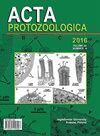Rumen Ciliate Biota of Domestic Cattle (Bos taurus taurus) in İstanbul, Turkey and Infraciliature of Metadinium medium (Entodiniomorphida, Ophryoscolecidae)
IF 1.2
4区 生物学
Q4 MICROBIOLOGY
引用次数: 4
Abstract
The species composition and distribution of ciliates were investigated in the rumen contents of 15 domestic cattle (Bos taurus taurus L.) living in the European part of Istanbul, Turkey. Thirty-five species and 13 morphotypes belonging to 13 genera were identified. The density of rumen ciliates in cattle was 31.8 (± 21.3) × 104 cells ml−1, and the mean number of ciliate species per host was 12.9 ± 4.4. Of the ciliate species, Dasytricha ruminantium, Entodinium simulans, and Isotricha prostoma were the most abundant, each with a prevalence of 93.3%, whereas Diplodinium anisacanthum, D. dogieli, D. rangiferi, Enoploplastron triloricatum, Metadinium medium, and Ostracodinium munham were detected only in one animal (6.7% prevalence). Eodinium posterovesiculatum m. bilobosum and D. dogieli are new host records for cattle in Turkey. The infraciliature of M. medium (Entodiniomorphida, Ophryoscolecidae) was examined and detected for the first time. The buccal infraciliature of M. medium was composed of three polybrachykineties, a kinety loop, and paralabial kineties. A large dorso-adoral polybrachykinety, a gentle S-shaped curved vestibular polybrachykinety, and a kinety loop between the dorso-adoral polybrachykinety and adoral polybrachykinety were characteristics. Because of these features, M. medium-type buccal infraciliature was between the Ostracodinium gracile-type buccal infraciliature and the Ostracodinium mammosum-type buccal infraciliature.土耳其İstanbul地区家牛瘤胃纤毛虫生物群与金属基质的基础结构(内二形目,眼虫科)
对土耳其伊斯坦布尔欧洲区15头家牛(Bos taurus taurus L.)瘤胃内容物中纤毛虫的种类组成和分布进行了研究。共鉴定出13属35种13种形态。牛瘤胃纤毛虫密度为31.8(±21.3)× 104个细胞ml - 1,平均每宿主纤毛虫数为12.9±4.4种。其中,反刍盘尾虫、拟拟盘尾虫和异盘尾虫最多,患病率为93.3%,而异棘盘尾虫、dogieli盘尾虫、rangiferi盘尾虫、三叉盘尾虫、meadinium medium和munham盘尾虫仅检出1只(患病率为6.7%)。土耳牛的新寄主记录为后囊棘棘球蚴(odinium posterovesiculatum m. bilobosum)和dogieli。本文首次对中野田鼠(内二形虫,鞘翅科)进行了基础结构检测。M. medium的颊部结构由3个多臂结构、1个关节环和副关节结构组成。大的背-口多短促运动,温和的s形前庭多短促运动,以及在背-口多短促运动和口多短促运动之间的运动环。由于这些特征,中型介形虫的颊部结构介于细叶介形虫和长毛介形虫之间。
本文章由计算机程序翻译,如有差异,请以英文原文为准。
求助全文
约1分钟内获得全文
求助全文
来源期刊

Acta Protozoologica
生物-微生物学
CiteScore
2.00
自引率
0.00%
发文量
8
审稿时长
>12 weeks
期刊介绍:
Acta Protozoologica - International Journal on Protistology - is a quarterly journal that publishes current and comprehensive, experimental, and theoretical contributions across the breadth of protistology, and cell biology of Eukaryote microorganisms including: behaviour, biochemistry and molecular biology, development, ecology, genetics, parasitology, physiology, photobiology, systematics and phylogeny, and ultrastructure. It publishes original research reports, critical reviews of current research written by invited experts in the field, short communications, book reviews, and letters to the Editor.
 求助内容:
求助内容: 应助结果提醒方式:
应助结果提醒方式:


